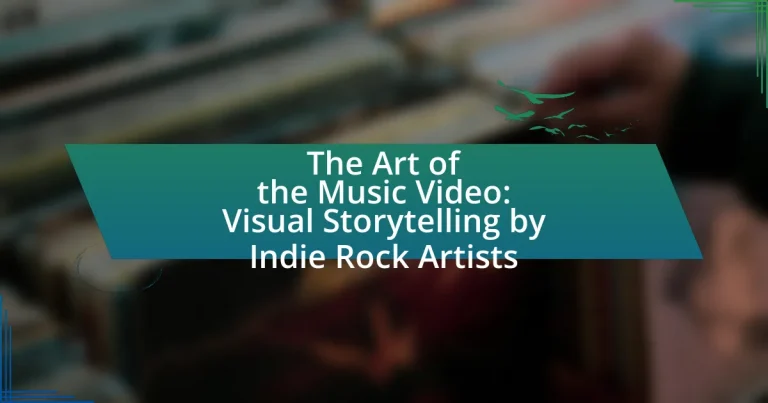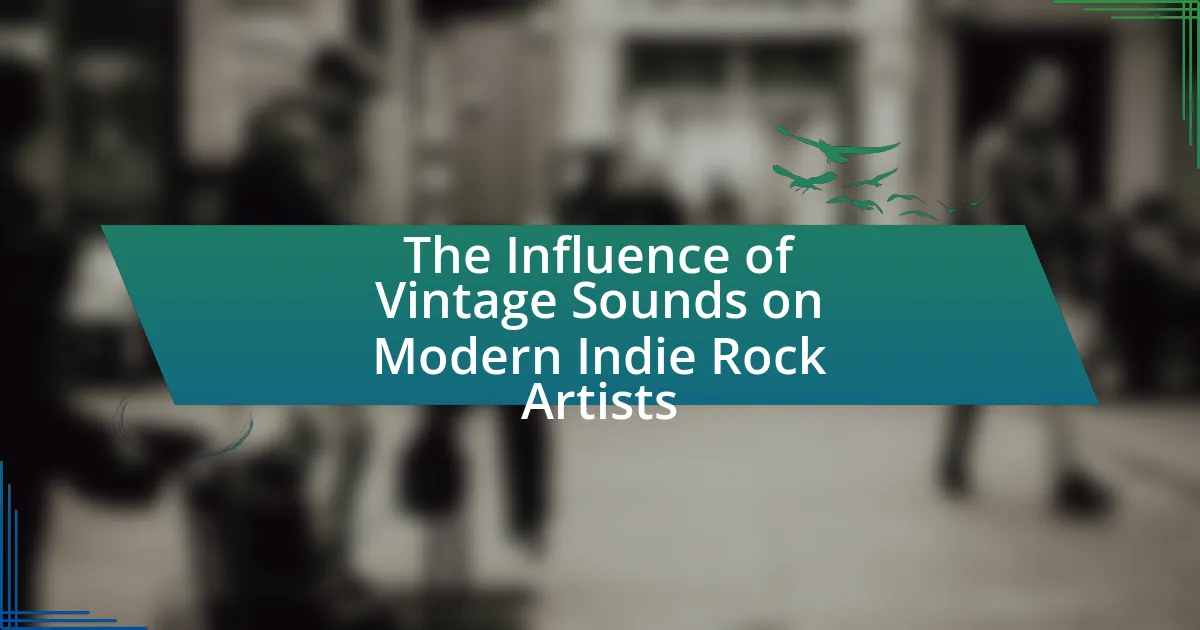The article explores the art of music videos in the indie rock genre, emphasizing their role in creative visual storytelling that aligns with the music’s themes and emotions. It examines how indie rock artists utilize unique aesthetics, narrative techniques, and experimental visuals to enhance audience engagement and convey deeper meanings. Key components discussed include the importance of narrative structure, cinematography, lighting, and editing in shaping the viewer’s experience. Additionally, the article highlights the significance of music videos for branding, cultural reflection, and social commentary, providing insights into best practices for indie rock artists in video production.
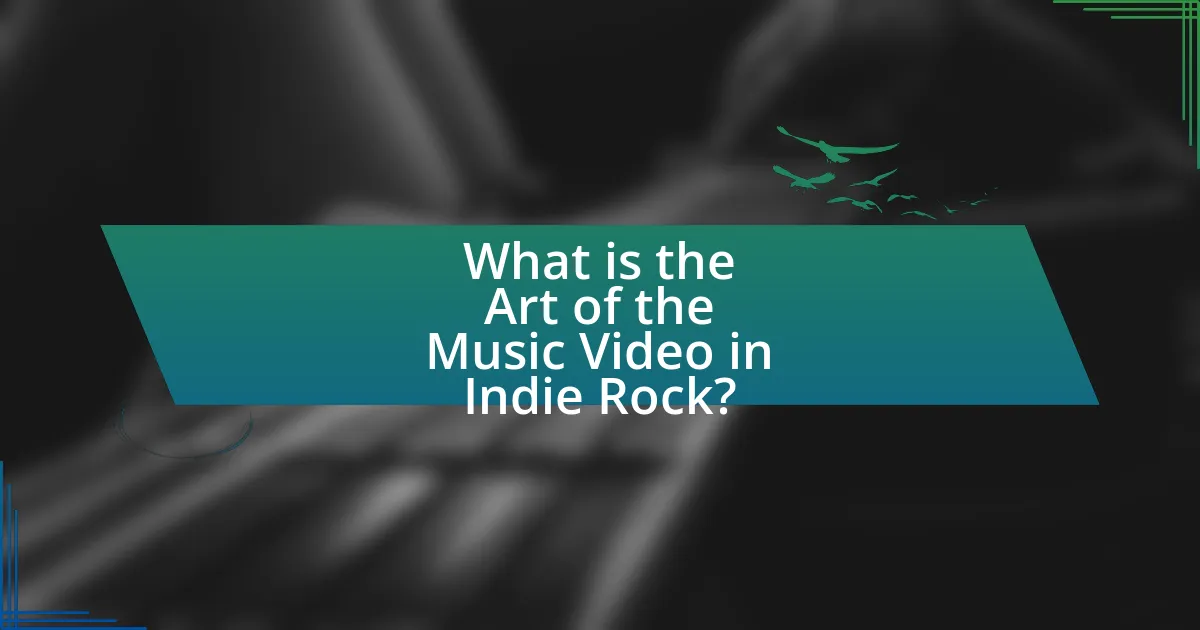
What is the Art of the Music Video in Indie Rock?
The art of the music video in indie rock is characterized by its emphasis on creative visual storytelling that often reflects the themes and emotions of the music. Indie rock artists utilize music videos as a medium to express their artistic vision, often incorporating unique aesthetics, narrative elements, and experimental techniques that distinguish them from mainstream productions. For example, the music video for “Take Me Out” by Franz Ferdinand employs a minimalist yet striking visual style that complements the song’s energetic rhythm and lyrical content. This approach not only enhances the listener’s experience but also allows artists to convey deeper meanings and connect with their audience on a more personal level.
How do music videos enhance storytelling in indie rock?
Music videos enhance storytelling in indie rock by visually interpreting the themes and emotions conveyed in the music, creating a deeper connection with the audience. These videos often utilize narrative techniques, such as character development and plot progression, to complement the lyrics and musical composition. For instance, the music video for “The Night We Met” by Lord Huron employs a haunting visual narrative that reflects the song’s themes of longing and nostalgia, effectively amplifying the emotional impact. Additionally, indie rock music videos frequently incorporate artistic visuals and symbolism, which can evoke specific feelings and interpretations, further enriching the storytelling experience.
What visual techniques are commonly used in indie rock music videos?
Indie rock music videos commonly utilize visual techniques such as narrative storytelling, surreal imagery, and DIY aesthetics. Narrative storytelling often involves a plot that reflects the song’s themes, engaging viewers emotionally and creating a connection with the music. Surreal imagery is frequently employed to evoke feelings of nostalgia or dream-like states, enhancing the artistic expression of the genre. Additionally, DIY aesthetics, characterized by low-budget production and a raw, unpolished look, emphasize authenticity and individuality, which are core values in indie rock culture. These techniques collectively contribute to the unique visual identity of indie rock music videos, making them distinct from mainstream productions.
How do narrative elements contribute to the overall impact of a music video?
Narrative elements significantly enhance the overall impact of a music video by providing context, emotional depth, and a cohesive storyline that engages viewers. These elements, such as character development, plot progression, and thematic consistency, create a relatable experience that resonates with the audience. For instance, a music video that tells a story of love and loss can evoke strong emotions, making the song more memorable and impactful. Research indicates that viewers are more likely to remember and connect with music videos that incorporate a clear narrative structure, as it helps to reinforce the song’s message and themes. This connection between narrative and viewer engagement is crucial in the competitive landscape of music videos, where emotional resonance can lead to increased sharing and popularity.
Why are music videos important for indie rock artists?
Music videos are important for indie rock artists because they serve as a vital tool for creative expression and audience engagement. These visual narratives allow artists to convey their artistic vision, enhance the emotional impact of their music, and differentiate themselves in a crowded market. According to a 2021 study by the International Federation of the Phonographic Industry, 80% of consumers prefer to watch a music video over listening to audio alone, highlighting the effectiveness of visual content in capturing audience attention. Additionally, platforms like YouTube and social media amplify the reach of these videos, enabling indie rock artists to build a fanbase and increase their visibility without the backing of major labels.
What role do music videos play in an artist’s branding and identity?
Music videos are crucial in shaping an artist’s branding and identity by visually representing their music and personal style. They serve as a platform for artists to convey their artistic vision, establish a unique aesthetic, and connect emotionally with their audience. For instance, iconic music videos like Michael Jackson’s “Thriller” not only showcased innovative storytelling but also solidified his status as a cultural icon, demonstrating how visual elements can enhance an artist’s brand. Furthermore, research indicates that 70% of music consumers are more likely to remember an artist after watching their music video, highlighting the effectiveness of this medium in reinforcing brand recognition and identity.
How can music videos influence audience engagement and reach?
Music videos can significantly influence audience engagement and reach by combining visual storytelling with music, creating a more immersive experience. This multimedia approach captures attention more effectively than audio alone, as studies show that visuals can enhance memory retention by up to 65%. Furthermore, music videos often encourage sharing on social media platforms, increasing their reach; for instance, a popular music video can generate millions of views within days, amplifying the artist’s visibility. Additionally, the emotional connection established through compelling visuals can lead to higher viewer engagement, as audiences are more likely to connect with the narrative and themes presented in the video.
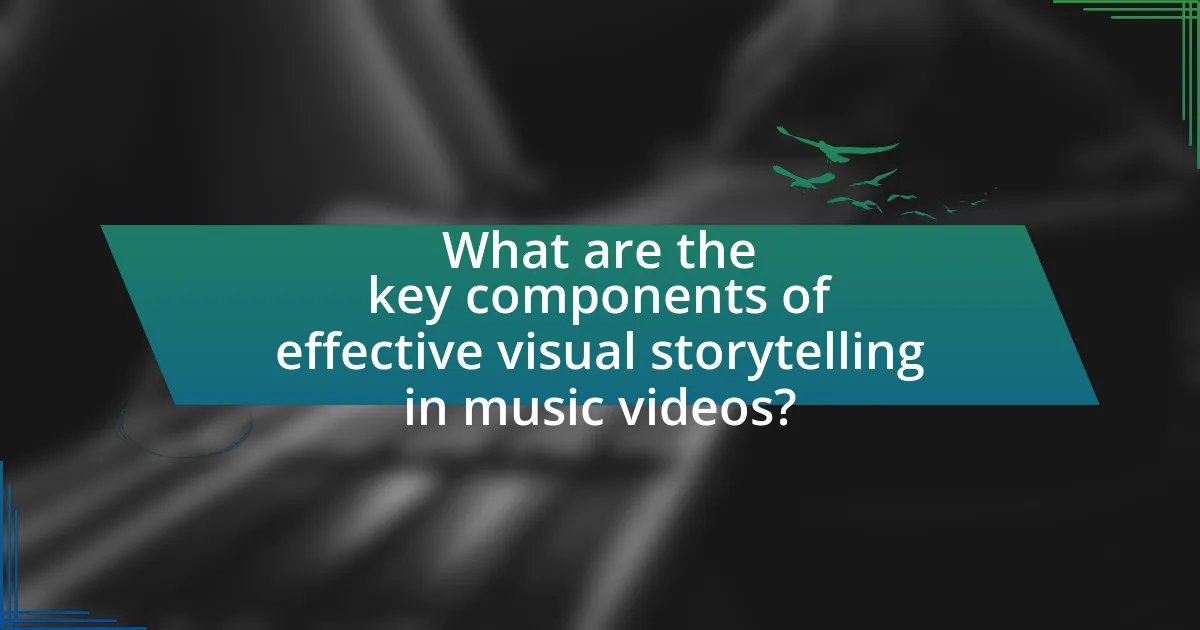
What are the key components of effective visual storytelling in music videos?
The key components of effective visual storytelling in music videos include narrative structure, visual aesthetics, emotional engagement, and synchronization with music. Narrative structure provides a coherent storyline that guides viewers through the video, often reflecting the song’s themes. Visual aesthetics, such as color schemes, cinematography, and set design, enhance the overall mood and complement the music. Emotional engagement is crucial, as it connects the audience to the characters and story, often eliciting feelings that resonate with the song’s message. Synchronization with music ensures that visual elements align with the rhythm and lyrics, creating a cohesive experience. These components work together to create a compelling visual narrative that enhances the impact of the music.
How does cinematography affect the storytelling in music videos?
Cinematography significantly affects storytelling in music videos by shaping the visual narrative and emotional tone. Through techniques such as camera angles, lighting, and shot composition, cinematography conveys themes and emotions that align with the music’s message. For instance, close-up shots can create intimacy, while wide shots can establish context or isolation. Research indicates that visual elements in music videos can enhance viewer engagement and retention, as seen in studies showing that well-executed cinematography increases audience connection to the song’s narrative. Thus, effective cinematography is essential for translating the artist’s vision into a compelling visual story.
What are the essential cinematographic techniques used in indie rock videos?
Essential cinematographic techniques used in indie rock videos include handheld camera work, natural lighting, and unconventional framing. Handheld camera work creates an intimate and raw aesthetic, often reflecting the emotional tone of the music. Natural lighting enhances authenticity and connects the viewer to the environment, while unconventional framing, such as off-center compositions, adds a unique visual style that distinguishes indie rock videos from mainstream productions. These techniques are frequently employed to evoke a sense of realism and personal connection, aligning with the genre’s ethos of authenticity and artistic expression.
How does lighting contribute to the mood and narrative of a music video?
Lighting significantly influences the mood and narrative of a music video by establishing atmosphere and guiding viewer emotions. For instance, bright, high-key lighting often conveys happiness and energy, while low-key lighting can create tension or evoke sadness. Specific techniques, such as color temperature adjustments, can further enhance emotional responses; warm tones may suggest intimacy, while cool tones can imply detachment. Research indicates that lighting choices directly affect audience perception, as demonstrated in studies where viewers reported varying emotional reactions based on lighting conditions in visual media. Thus, effective lighting not only supports the narrative but also shapes the overall viewer experience in music videos.
What role does editing play in shaping the narrative of a music video?
Editing plays a crucial role in shaping the narrative of a music video by determining the pacing, structure, and emotional impact of the visual storytelling. Through techniques such as cuts, transitions, and sequencing, editing can enhance the connection between the music and the visuals, guiding the viewer’s experience and interpretation of the song’s themes. For instance, rapid cuts can create a sense of urgency or excitement, while slower transitions may evoke introspection or melancholy. Research indicates that effective editing can significantly influence audience engagement and emotional response, as seen in studies analyzing viewer reactions to different editing styles in music videos.
How do pacing and rhythm in editing enhance the viewer’s experience?
Pacing and rhythm in editing significantly enhance the viewer’s experience by creating emotional engagement and maintaining narrative flow. Effective pacing controls the speed at which scenes unfold, allowing viewers to absorb key moments, while rhythm establishes a visual tempo that aligns with the music, reinforcing the emotional tone. For instance, quick cuts during high-energy sections of a song can evoke excitement, while slower transitions during reflective moments can foster introspection. Research indicates that well-edited music videos, such as those by indie rock artists, utilize these techniques to evoke specific emotional responses, thereby increasing viewer retention and enjoyment.
What are common editing styles found in indie rock music videos?
Common editing styles found in indie rock music videos include jump cuts, montage sequences, and slow motion. Jump cuts create a sense of urgency and energy, often reflecting the fast-paced nature of the music. Montage sequences are used to convey a narrative or emotional journey, combining various clips to evoke feelings or themes relevant to the song. Slow motion is frequently employed to emphasize specific moments or emotions, allowing viewers to connect more deeply with the visuals. These editing techniques are prevalent in indie rock videos, as they enhance storytelling and artistic expression, aligning with the genre’s focus on creativity and individuality.
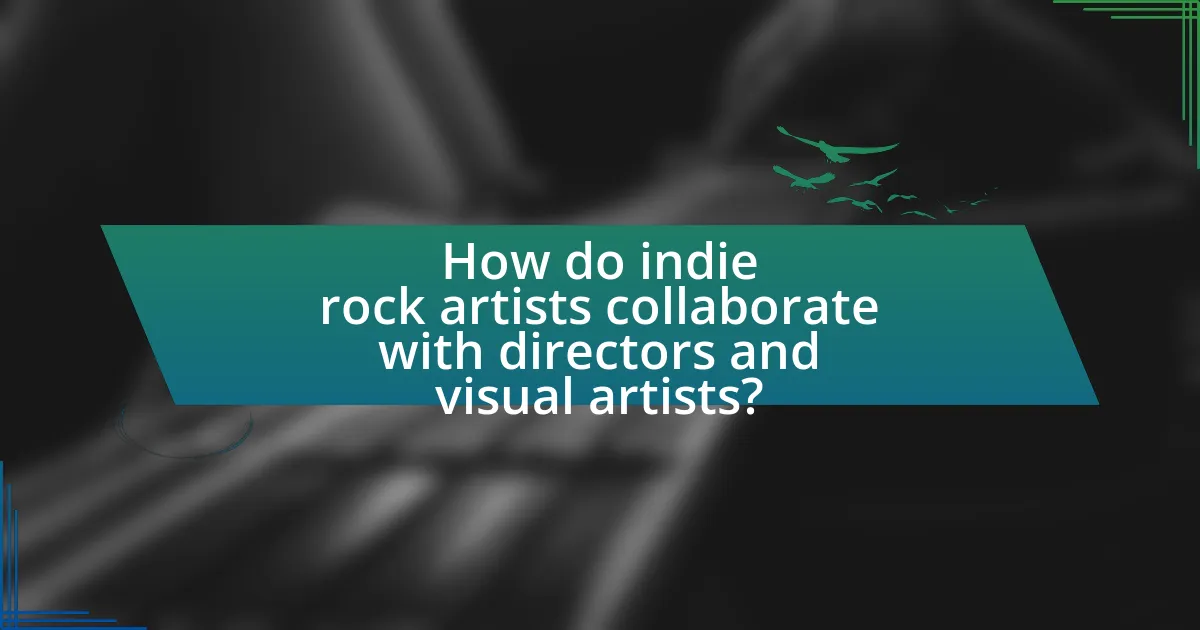
How do indie rock artists collaborate with directors and visual artists?
Indie rock artists collaborate with directors and visual artists primarily through the creation of music videos, where they work together to develop a visual narrative that complements the song’s themes. This collaboration often involves brainstorming sessions where artists share their vision, leading to the development of concepts that reflect the emotional and aesthetic qualities of the music. For instance, the band Arcade Fire has collaborated with director Spike Jonze to create visually striking music videos that enhance the storytelling aspect of their songs. Additionally, indie rock artists frequently engage visual artists for album artwork and promotional materials, ensuring a cohesive visual identity that resonates with their audience. This synergy between music and visual art is essential in indie rock, as it helps to establish a unique brand and deepen the listener’s experience.
What is the process of creating a music video from concept to execution?
The process of creating a music video from concept to execution involves several key stages: pre-production, production, and post-production. In pre-production, the creative team develops the concept, writes a treatment, and plans the visual narrative, including storyboarding and location scouting. During production, the video is filmed according to the planned shots, utilizing cameras, lighting, and sound equipment. Finally, in post-production, the footage is edited, color-graded, and combined with audio to create the final product. This structured approach ensures that the music video effectively conveys the intended artistic vision and engages the audience.
How do artists and directors communicate their vision for a music video?
Artists and directors communicate their vision for a music video through detailed discussions, visual references, and storyboards. These methods allow them to align their creative ideas and ensure a cohesive interpretation of the song’s themes. For instance, artists often share their inspirations, emotions, and desired aesthetics, while directors may present visual styles and narrative concepts that resonate with the music. This collaborative process is essential for translating the song’s message into a visual format, as evidenced by the use of storyboards that outline scenes and camera angles, facilitating a shared understanding of the final product.
What factors influence the choice of director for a music video project?
The choice of director for a music video project is influenced by the director’s previous work, their understanding of the artist’s vision, and their ability to convey the song’s narrative effectively. Directors with a strong portfolio that aligns with the genre or style of the music are often preferred, as their experience can enhance the visual storytelling. Additionally, the director’s creative approach and ability to collaborate with the artist and production team play a crucial role in the selection process. For instance, directors who have successfully executed similar projects or have a unique artistic style that resonates with the indie rock aesthetic are more likely to be chosen.
How do indie rock music videos reflect cultural and social themes?
Indie rock music videos reflect cultural and social themes by visually representing the narratives and emotions associated with contemporary societal issues. These videos often incorporate imagery that critiques consumerism, explores identity, and addresses political unrest, thereby resonating with audiences who relate to these themes. For instance, the music video for “This Is America” by Childish Gambino uses stark visuals to comment on gun violence and racial inequality in the United States, effectively merging artistic expression with social commentary. Such representations in indie rock music videos serve to engage viewers in critical discussions about the world around them, making the medium a powerful tool for cultural reflection.
What are some examples of music videos that address social issues?
Some examples of music videos that address social issues include “This Is America” by Childish Gambino, which critiques gun violence and systemic racism in the United States, and “Fight the Power” by Public Enemy, which confronts racial inequality and social injustice. Additionally, “Praying” by Kesha addresses themes of abuse and empowerment, while “Same Love” by Macklemore & Ryan Lewis advocates for LGBTQ+ rights and acceptance. Each of these videos uses powerful imagery and storytelling to highlight significant societal challenges.
How do cultural references in music videos resonate with audiences?
Cultural references in music videos resonate with audiences by creating a shared context that enhances emotional engagement and relatability. These references often draw from popular culture, historical events, or social issues, allowing viewers to connect their personal experiences with the themes presented in the video. For instance, a music video that incorporates iconic imagery from a specific era can evoke nostalgia, while references to contemporary social movements can foster a sense of solidarity among viewers. Research indicates that audiences are more likely to remember and engage with content that reflects their cultural background, as demonstrated in studies showing that familiarity with cultural symbols increases viewer retention and emotional response.
What are best practices for indie rock artists when creating music videos?
Indie rock artists should prioritize authenticity and storytelling when creating music videos. Authenticity resonates with audiences, allowing artists to connect on a personal level, while a strong narrative enhances viewer engagement. For instance, using relatable themes or personal experiences can create a compelling visual story that reflects the song’s message. Additionally, collaborating with local filmmakers or artists can bring fresh perspectives and creativity, often resulting in unique visual styles that stand out. Research indicates that music videos with a clear narrative structure tend to have higher viewer retention rates, reinforcing the importance of storytelling in this medium.
How can artists effectively budget for their music video projects?
Artists can effectively budget for their music video projects by creating a detailed breakdown of all anticipated costs, including pre-production, production, and post-production expenses. This involves estimating costs for locations, equipment, crew, talent, permits, and editing. For instance, a study by the Music Industry Research Association found that indie artists often allocate around 30% of their budget to production and 20% to post-production, highlighting the importance of careful financial planning. Additionally, artists should seek quotes from vendors and compare prices to ensure they are getting the best value for their budget. By maintaining a clear budget and tracking expenses throughout the project, artists can avoid overspending and ensure their music video aligns with their financial capabilities.
What tips can enhance the creative process of making a music video?
To enhance the creative process of making a music video, artists should prioritize a clear narrative that aligns with the song’s themes. A well-defined storyline helps to engage viewers and provides a cohesive visual experience. Additionally, collaborating with a diverse team of creatives, including directors, cinematographers, and editors, can bring fresh perspectives and innovative ideas, as evidenced by successful indie rock videos that often feature unique visual styles and storytelling techniques. Utilizing mood boards and visual references can also streamline the creative process, ensuring that everyone involved shares a unified vision. Finally, experimenting with different filming techniques and locations can lead to unexpected and captivating results, as seen in various acclaimed music videos that push the boundaries of traditional formats.
